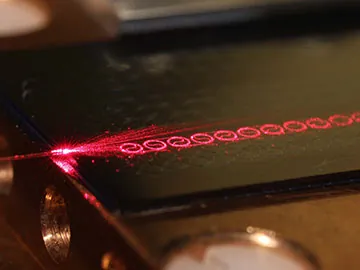
Revolutionizing Amplification: Spiral Waveguides Expand Bandwidth for Telecom
2025-04-15
Author: Noah
In a groundbreaking development from Sweden, scientists have unveiled a method to significantly amplify laser light at telecommunications wavelengths using innovative single-mode spiral waveguides on photonic chips. This advancement holds the potential to enhance not just telecommunications but also medical imaging and material testing.
The Challenge of Rising Internet Traffic
As social media, video streaming, and artificial intelligence continue to proliferate, internet traffic is expected to soar. A major hurdle in keeping up with this demand is the limited bandwidth of optical amplifiers, which are crucial for maintaining a strong signal-to-noise ratio along fiber optic links.
A Breakthrough in Nonlinear Amplification
Instead of relying solely on stimulated emission, researchers are increasingly turning to four-wave mixing, a nonlinear phenomenon. By directing a weak signal and a robust pump beam at a medium with third-order nonlinearity, they can generate a more potent output signal alongside an idler beam.
Achieving Anomalous Dispersion with Single Modes
A critical requirement for this method is achieving anomalous dispersion, where the medium's refractive index rises with increasing wavelength. This ensures proper phase matching between different waves, maximizing both gain and bandwidth. Previous attempts used waveguides with multiple optical modes, which often led to power losses and signal distortion.
Chalmers University’s Innovative Spiral Design
The team led by Peter Andrekson at Chalmers University has successfully created a solution: they've optimized a single-mode waveguide's 3D structure by spiraling it, essentially cutting off higher-order modes while still maintaining anomalous dispersion. Their design includes two types of waveguides etched from silicon nitride on a silicon wafer, featuring spirals of varying lengths.
Impressive Results: A Tenfold Bandwidth Increase
In experiments, the researchers found that their 56 cm-long waveguide could amplify signals across a remarkable bandwidth of approximately 300 nm, covering wavelengths from 1400 to 1700 nm — about ten times the bandwidth of current amplifiers. This breakthrough opens doors for enhanced data transmission capabilities.
Looking Ahead: Enhancements and New Applications
While the technology shows promise, the researchers acknowledge it needs to be refined before real-world application. Their goal is to boost the amplification to around 20 dB by extending the length of the waveguides. Currently, they’ve achieved lengths of up to 1.4 m.
Additionally, the researchers envision adapting this technology for various wavelengths with the potential for medical uses such as disease diagnosis and surgical guidance, as well as inspecting manufactured materials. This innovative amplification technique could revolutionize multiple fields and help meet the ever-increasing demands for bandwidth.









 Brasil (PT)
Brasil (PT)
 Canada (EN)
Canada (EN)
 Chile (ES)
Chile (ES)
 Česko (CS)
Česko (CS)
 대한민국 (KO)
대한민국 (KO)
 España (ES)
España (ES)
 France (FR)
France (FR)
 Hong Kong (EN)
Hong Kong (EN)
 Italia (IT)
Italia (IT)
 日本 (JA)
日本 (JA)
 Magyarország (HU)
Magyarország (HU)
 Norge (NO)
Norge (NO)
 Polska (PL)
Polska (PL)
 Schweiz (DE)
Schweiz (DE)
 Singapore (EN)
Singapore (EN)
 Sverige (SV)
Sverige (SV)
 Suomi (FI)
Suomi (FI)
 Türkiye (TR)
Türkiye (TR)
 الإمارات العربية المتحدة (AR)
الإمارات العربية المتحدة (AR)